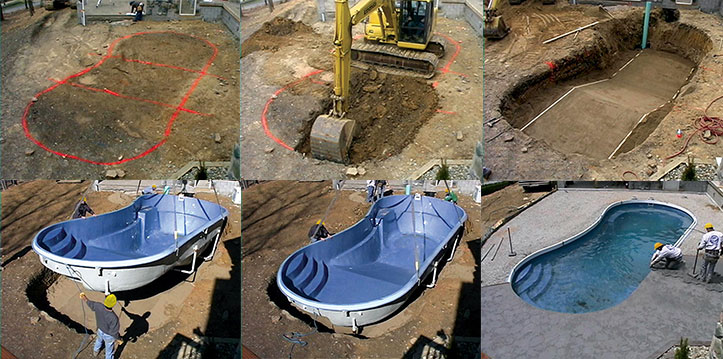Dreaming of a backyard oasis but concerned about the hefty price tag? Installing a fiberglass pool yourself might be the solution you’re looking for—if you know what you’re getting into.
The difference between a successful project and a costly mistake often comes down to understanding which parts of the installation you can handle yourself and which require professional expertise.
Contents
Key Facts About Doing Your Pool Install By Yourself
A DIY fiberglass pool install is possible but requires careful planning and skill assessment. Homeowners can often save significantly compared to full-service installation by eliminating labor costs.
The process isn’t simply “dig, drop, and fill” as some might think. It involves precise excavation, proper shell handling, accurate leveling, and correct backfilling—all requiring specialized knowledge.
- Cost savings: Significant reduction in overall project expense
- Skill required: Technical knowledge of excavation, plumbing, and construction
- Time commitment: Typically 1-2 weeks for the complete installation process

Pros and Cons of a Building a Fiberglass Pool by Yourself
Taking on your own fiberglass pool installation gives you complete control over the project timeline. You’ll avoid the long wait times often associated with professional installers during busy seasons.
The personal satisfaction of creating a backyard oasis your family will enjoy for years is another compelling reason many homeowners consider the DIY route.
However, without proper knowledge, you might violate building codes or improperly install critical components. The fiberglass shell weighs thousands of pounds and requires specialized equipment to place correctly.
Many manufacturers will void their warranties if their pools aren’t installed by certified professionals, a significant risk to consider before committing to a constructing a fiberglass pool.
Legal and Warranty Factors to Keep in Mind
Most municipalities require permits for inground pool installation, regardless of who does the work. These permits often involve detailed plans and inspections at various stages. Visit USA.Gov to find your municipality and their rules for installing in ground pools.
Failing to obtain proper permits can result in fines, forced removal, or complications when selling your home. Before starting your DIY project, check with local building authorities about specific requirements.
Warranty protection is another crucial consideration. Most fiberglass pool manufacturers specify that professional installation is required to maintain warranty coverage. Review warranty documentation carefully to understand what might void your protection.
Steps for a Fiberglass Pool Install
Site Preparation and Excavation
The first step involves precisely marking your pool’s location. You’ll need to arrange for utility companies to mark underground lines before any digging begins.
For the excavation itself, most DIYers rent heavy equipment or hire an excavation contractor while maintaining overall project management. The hole typically needs to be about 12 inches larger than the pool dimensions on all sides.

Lowering and Leveling the Shell
This critical step requires a crane or specialized equipment to safely lower the shell into the excavated hole. Perfect leveling is essential—even small errors can cause structural problems later.
The shell must be supported properly during placement to prevent flexing or distortion. Many DIY installers struggle with this step, as it requires precision and specialized equipment.
Backfilling and Plumbing Setup
Proper backfilling materials and techniques are essential for long-term stability. Most DIY fiberglass pool install projects use a combination of:
- Gravel for drainage around the bottom
- Sand for the sides of the pool
- Flowable Fill (a specialized concrete mix) for additional support
Plumbing must be installed with proper slopes for drainage and secure connections. Pressure testing before completing backfill is essential to identify any leaks while they’re still accessible.
Coping, Decking, and Finishing Touches
The area surrounding your pool requires careful finishing to ensure safety and aesthetics. Options include concrete decking, pavers, or composite materials.
The coping (edge material where the pool meets the deck) must be installed to prevent water infiltration behind the shell. Final inspections are typically required before the pool can be filled and used.
Common Issues That Trip Up DIYers
Soil Shifts
Unexpected soil conditions create serious challenges during installation. High water tables may cause the empty shell to float, while unstable soil can lead to settling issues later.
Professional installers know how to identify and address these conditions, but DIYers often discover them only when problems arise. A soil test before beginning can help identify potential issues.
Equipment Access
Getting heavy machinery to your backyard can be surprisingly difficult. Narrow gates, overhead obstacles, and landscaping features may limit access for cranes and excavators.
Property damage is common when attempting to navigate tight spaces with large equipment. Carefully measure access points before committing to a DIY fiberglass pool install.

Professional Support Without Losing Control
You don’t have to choose between complete DIY and full-service installation. Many homeowners take a hybrid approach, handling some aspects themselves while hiring professionals for critical steps.
For example, you might manage the project and complete finishing work while contracting experts for excavation and shell placement. This approach preserves much of the cost savings while reducing risk.
Pool Brokers USA offers support packages that provide technical guidance, detailed specifications, and installation manuals. This allows you to maintain control of your project while having expert resources available.
Moving Forward With Confidence
Understanding what you can realistically handle yourself versus what requires professional expertise is key to a successful DIY fiberglass pool install. While the DIY route offers significant cost savings, the risks to warranty coverage and structural integrity must be carefully weighed.
For many homeowners, the ideal approach is somewhere in between—taking on appropriate portions of the project while getting expert help with critical steps. This balanced approach provides both satisfaction and savings without compromising quality.
Ready to explore your options? Request a Quote to learn how Pool Brokers USA can support your fiberglass pool project.
